What comes to mind when thinking of a typical corporate office of the past?
There’s a good chance you picture a lot of gray and beige color schemes with monotonous decor throughout. Carefully laid out cubicles as far as the eye can see, cutting through open space and hyper-segmenting everything in sight. If one is lucky enough to have windows, they are most likely in a corridor or reception area, so you can glance out of them occasionally. Full of static noise, harsh overhead lighting, and ambient temperature, these are not ideal conditions for people to be in for eight hours or more each day. Poor lighting and noise control can lead to various health issues, not to mention their impact on a typical workday.
What if this was not the standard? What if there was a way to improve overall well-being while reconnecting our modern indoor world with our biological affinity for the natural world?
What is Biophilic Wellness?
Biophilic design seems to be all around us these days when it comes to commercial design and construction. This trend-setting design philosophy taking hold of commercial architectural projects presents a dedicated emphasis on bridging our outdoor and indoor worlds together. The concept of incorporating some elements of the natural world into the built environment may seem like a response to elevate wellness due to Covid-19 and stay-at-home orders/work-from-home policies. However, the history of the nature-evoking design principle of biophilic wellness goes well beyond trend. Going back centuries, the Hanging Gardens of Babylon are an early example of a biophilic concept established as a typical form factor specified across divisions and segments of the built environment.
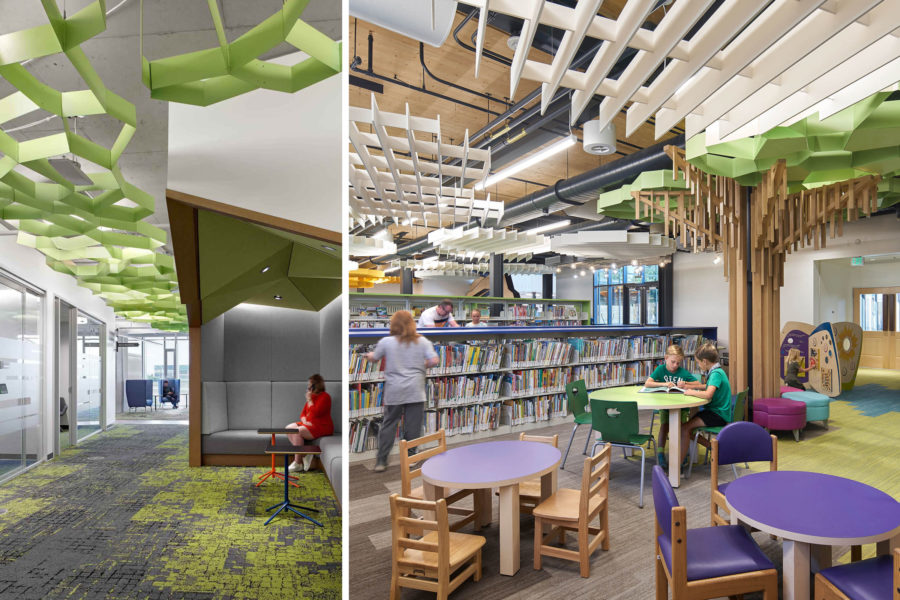
Acoustic ceiling panels can be used to mimic natural, biophilic elements like clouds or tree canopies. At left, Guidewire Office in Mississauga, Ontario, designed by Gensler, featuring Atmosphera® Adaptive Pulse by Arktura. Photo by Ben Rahn, A-Frame Photography. At right, Brentwood Library in California, designed by Mark Davis, features Atmosphera® Adaptive Pulse, SoftGrid® Round by Arktura. Photo by JNM Studio Photography
The meaning of biophilia comes from the Greek word “philia” meaning love of and “bio” meaning life, so it quite literally means love of life. In 1964 psychoanalyst Erich Fromm described biophilia as “the passionate love of life and all living things.” Then, in the 1980s, biologist Edward O. Wilson proposed the notion that all humans have an “innate and biological affinity for the natural world,” giving this theory a basis in human genetics. This idea evaded home and work decor until much later. Today biophilic design focuses on the theory that people spend so much time inside elements of the natural world, our outside world should be indoors as well.
Biophilic design is integrated into the building industry to increase connections with the natural world within the confines of a space. Throughout human evolution, people remain accustomed to being around nature for most of their daily lives, but this rate has decreased significantly. A US EPA study found that the average American spends 87% of their time indoors. Humans, no longer nomadic thanks in part to advances in travel and technology, have established permanent abodes that separate us from the outdoor world for safety and more. Because of this evolutionary affinity, humans today still have an innate desire to connect to the natural world.
Acoustic Wellness
Beyond plants at home or work, acoustic wellness is another key factor that contributes to overall health. Noise affects everyone differently; while some workers thrive in a busy, bustling, loud office environment, other more introverted employees may find this atmosphere distracting or worse—harmful.
Sounds reverberate throughout an office, sometimes out of our control, like outdoor noise making its way inside. It is important to consider these auditory challenges when creating a positive and productive work environment. “Over the last 10 years there has been a growing interest in acoustics … supported by an explosion of new, more accessible products to be able to tune spaces and achieve these [acoustic] standards,” says John Johnston, director of systems development at Arktura. Acoustic products from Arktura like ceiling baffles, panels, and partitions address these challenges while incorporating biophilic elements in their design patterns to create a sonically sound and calming work environment.
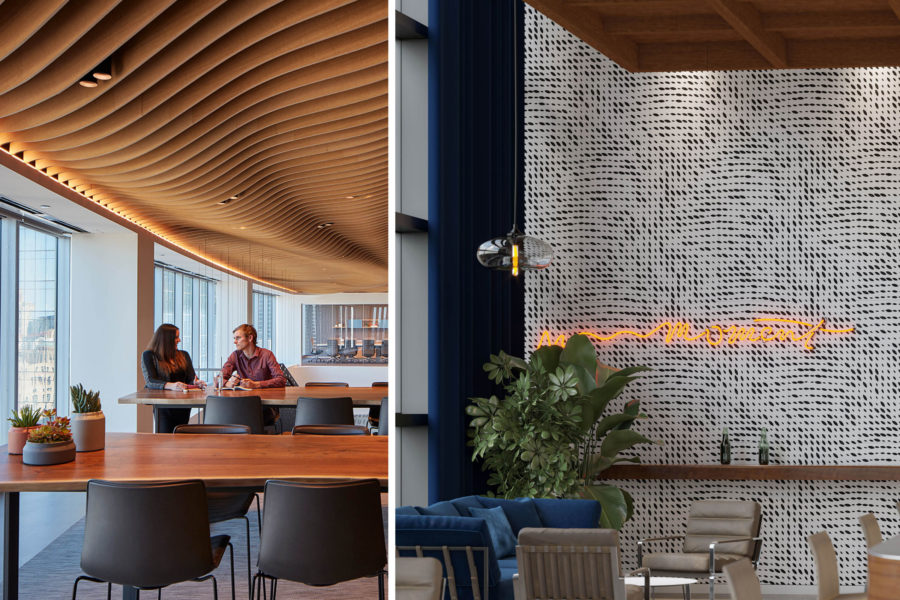
On the ceiling or the wall, pairing acoustic wellness with biophilic elements brings a serene atmosphere to these workplaces. At left, the Mead Johnson Office in Chicago, designed by Partners by Design features Atmosphera® Adaptive Analog 3D by Arktura. Photo by Tom Harris Architectural Photography. At right, see Vapor® Breeze by Arktura.
Biophilia in Action
The idea that nature should be a part of our indoor life as well seems to have always been a staple. From simple additions like adding images of nature and landscape art in a building or adding windows or artificial plants, workers feel less stress and more comfort with these small changes. Architects and designers are now taking that belief to new heights.
Advancements in biophilic design elevate this from a biological theory to a full-blown architectural movement. Biophilia can also have a tremendous number of cognitive benefits in everyday life. Happy, prolific employees are surrounded by natural, biophilic elements such as plants, water features, and natural light to reduce tension and increase focus.
“Thinking about the elegant way nature has solved problems often fuels the inspiration for solving architectural problems,” Johnston says. The emphasis of this design principle is on an overall emphasis on habitat and environment.
Biophilic design can also be the specification of skylights, glass egress openings to patio areas, inhabitable outdoor areas, water features, as well as natural material textures throughout such as wood or stone, in addition to introducing live plants or expansive windows. Many commercial projects adopt this practice in new construction as others begin to retrofit and adapt their office space to better align with these design principles. These choices seem to pay unexpected dividends as workplaces that offer more greenery led to more productivity, making employees more content, creative, and focused. Happier employees lead to higher retention rates and an increase in team morale as well as workflow.
While plants do a wonderful job at calming us, they have a secondary benefit, too—noise reduction. Noise may be a major issue in open office layouts. However, carefully positioned plants help quiet a space, with the plant both absorbing and deflecting sound.
Arktura’s acoustic products contain these environmentally friendly and sound dampening properties. Award-winning designs feature biophilic elements such as Vapor Bloom, which brings life to a space through nature evoking patterns that resemble leaves and petals. Vapor Sky emulates a cloud-like pattern, bringing the sky indoors, while Vapor Hue Flora features layers of organic prints over perforations to elicit a biophilic floral landscape.
This biophilic mindset is at the forefront of the design process at Arktura. “To me, natural forms and patterns are soothing, hopeful, and pleasant. When cleverly abstracted, they create timeless architectural features that satisfy many aesthetic tastes and contribute to wellness and comfort for a wide range of users,” says Moti Tavassoli, product design manager at Arktura.
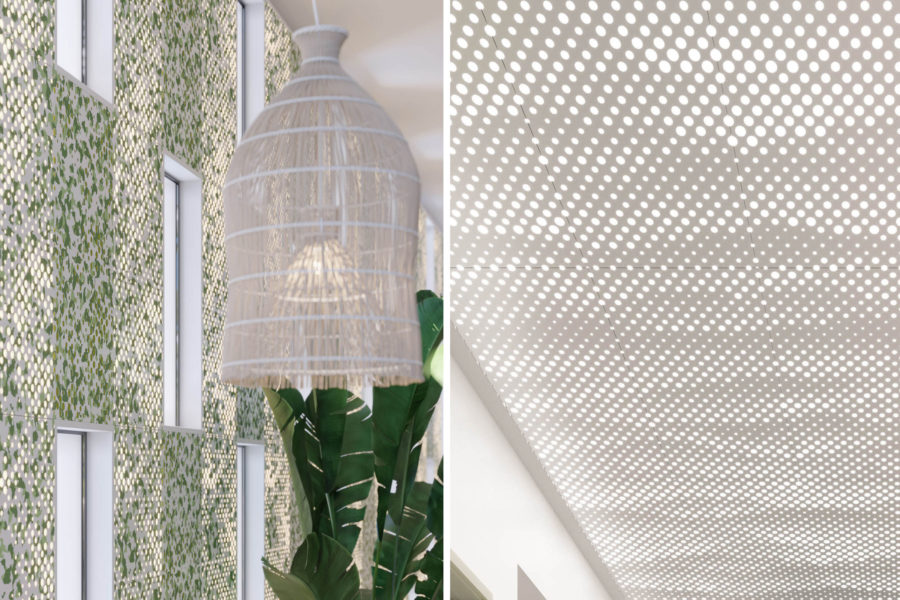
A modern take on green ivy walls without the plant care and maintenance. Vapor Hue™ Flora by Arktura at left. Vapor® Sky by Arktura at right.
Vapor Hue and Vapor Sky are available in a growing collection of colors, patterns, prints, and color schemes to fit in any commercial workplace. Biophilic designs that evoke natural elements help bring the look and feel of nature into an office or commercial space. These acoustic panels, partitions, clouds, and baffles not only look great but help to reduce noise in any size room.
In recent decades the popularity of open office layouts has grown thanks to better communication and collaboration among employees. This has also created unintended consequences such as noise control and lack of privacy for focused tasks. Nearby workers become distracted by even the quietest of discussions. Some workplaces that thrive on both individual and collaborative work should take acoustic wellness more seriously. Acoustic baffle systems like SoftGrid can be placed throughout an office floor or concentrated in clusters over breakout areas or collaborative workstations.
Meanwhile, Arktura’s partitions such as SoftScreen can easily and decoratively divide smaller work areas from each other, offering patterns with both full and partial division.
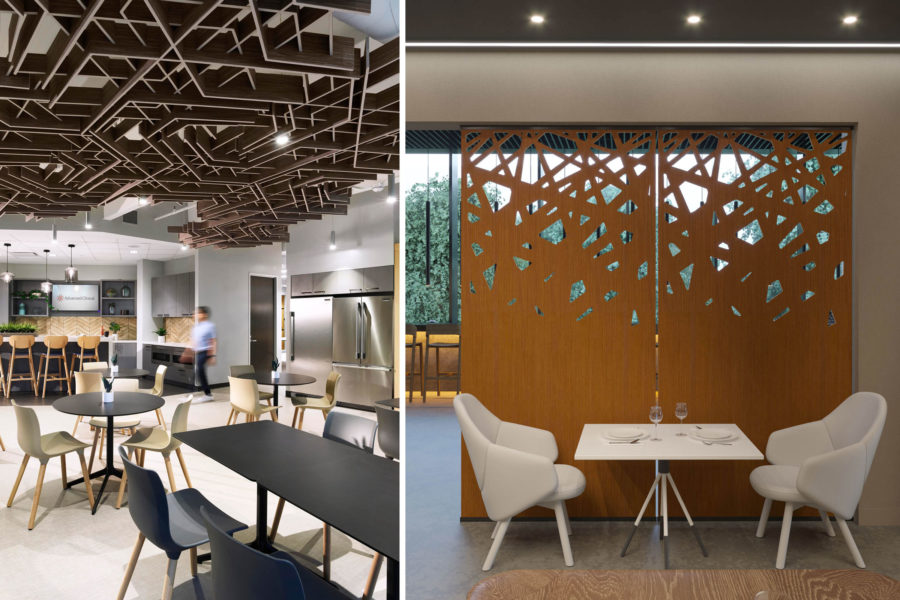
Acoustic baffles reduce sound in large open areas, while panels do a great job of creating privacy while maintaining openness. On the left, this advanced clinic in Chicago, designed by Box STUDIOS, features SoftGrid® Flux by Arktura. Photo by JJ Jetel Photography. At right, SoftScreen® Trace by Arktura.
The acoustic performance of a workplace should never be an afterthought. Modern office spaces with large open floorplans, high ceilings, concrete floors, and reflective surfaces bounce sound all around and direct it back to you. These sound levels are controlled by incorporating efficient acoustic design and planning to provide a peaceful environment for everyone occupying a space. This includes schools, offices, libraries, malls, theaters, and more.
Noisy environments can be harmful, not just distracting for patrons and employees. Even for a calm office, outside noise like traffic, music, people walking, and more can all have an impact. Studies show prolonged exposure to distracting levels of sound range from tiredness, stress, to pain, and high blood pressure. These underlying issues not only apply to people at work, but the adverse health effects can extend to their home life, leading to poor sleep, which in turn affects their work performance.
Proper acoustic design leads to better-focused, healthier, and more satisfied employees. “From an acoustic performance perspective, our mission here at Arktura is to control noise and contribute to the comfort and wellness of our clients,” Tavassoli says.
Using Color
In addition to biophilic design and sound control, color and patterns are unifying factors that tie these two design principles together. More than just a visual treat, color theory delves into the science and psychology behind color and the effect it has on our mood and behavior.
Color theory seeks to present designers and artists with a set of rules to convey specific feelings, desires, messages, and emotions through their desired medium. Color theory can be expansive and includes many overarching concepts about how certain colors relate to each other. However, in marketing terms, color psychology is focused on how color and patterns impact a consumer’s impressions of a brand or product. While not an exact science as emotional associations to colors vary from region to region, warm colors are usually associated with movement, energy, or light. On the other end of the color spectrum, cool colors often evoke feelings of peacefulness, calm, and relaxation.
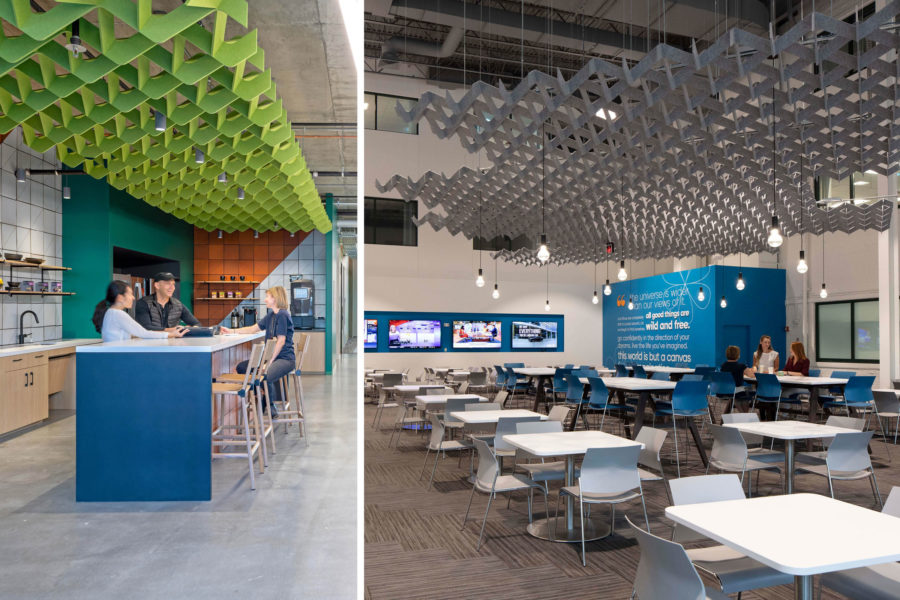
Calming waves are represented in these ceiling modules, perfect for concentrated or expansive areas. The lefthand image of Adobe 100 Hooper in San Francisco, designed by Gensler, shows SoftGrid® Wave by Arktura. Photo by Jasper Sanidad Photography. On the right, SoftGrid® Wave by Arktura is on display at 300 Baker in Concord, Massachusetts, designed by SGA Architects. Photo by Ari Burling Photography.
Arktura’s product development team considers these factors when developing a line that contains various finishes. “As a designer, one of my main goals for patterns is to ensure they are non-imposing and blend well with the existing architectural features while creating a sense of excitement, wellness, and hope,” Tavassoli says.
From cool to warm tones, coordinating color schemes throughout a project, and biophilic patterns incorporating a multitude of offerings, Arktura’s architectural goods can help take design to the next level. Not only do these projects look great, but they have auditory benefits as well. Whether it is a cool-tone acoustic baffle, all-white wall to ceiling panels, or perforated wall fixture displaying an image of a serene nature scape, these can help bring a little life to any office. Arktura also features Soft Sound wood textures in product lines like the SoftSpan and more.
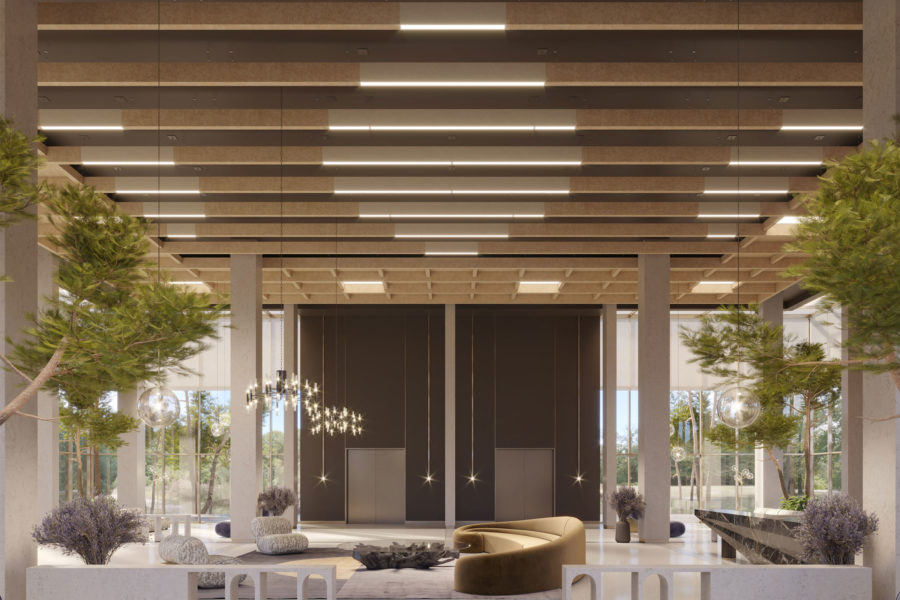
Plenty of natural light, plants, and natural materials bring a strong biophilic aesthetic to this commercial application. This project shows SoftSpan® 48A + SoundBar® by Arktura.
All these elements come together to bring a new lease on life to a commercial space. Whether a minor change like incorporating plants and outdoor space or more thorough adaptations to intent such as retrofitting an office with Arktura goods, bringing biophilic design and acoustic wellness to any space is an innovative and thoughtful way to benefit those most important to your company, your clients, your team, and your organization.


